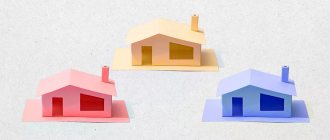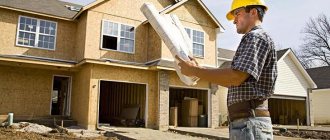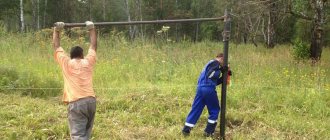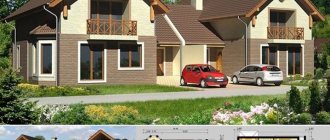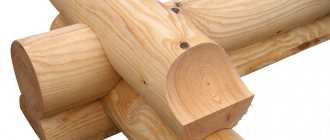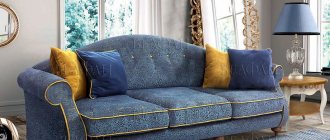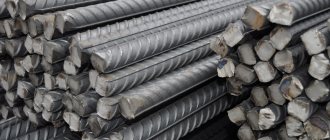A symmetrical house is a private residence with an entrance in the central part and two identical wings to the left and right of the entrance group. As a rule, this is a fairly spacious property intended for a large family. The peculiarity of a symmetrical house in traditional architecture is a classic. But now architects have learned to play with ultra-modern styles here - constructivism, modern, hi-tech, minimalism. It is this solution that is presented in the photo of a symmetrical house from the London architectural bureau Cullinan Studio.
house symmetrical project
Let's consider the project of a modern symmetrical house, its features, why and for whom such housing is suitable.
Why did I decide to build a house
I spent 20 years of my life in my parents’ house in the Leningrad region and simply could not imagine myself in an apartment. Therefore, when the time came to get my own home, I decided to build a house.
At first I planned to build a house on the seashore: I bought a plot of land in Yevpatoria, where I wanted to move for permanent residence, and started saving for the box of a house. But the plans were not destined to come true: the parents’ house burned down, and there was nowhere to live. Then I couldn’t think of anything better than to sell a plot by the sea for 1,200,000 rubles and build a house in my homeland - in the city of Novaya Ladoga, Leningrad region.
Advantages of a one-story house
The advantages of a one-story house over two- and three-story analogues are obvious.
Layout option for a one-story house 9x9
To build a classic one-story house, you can choose any material on the market and use almost any type of foundation, based on the characteristics of the soil on which the house will be built. And also the location of all rooms in the same plane and the absence of stairs is one of the main advantages of low-rise buildings.
Due to the absence of the need to arrange interfloor communication, you can refuse to use a spacious hallway or hall, and use the freed-up space for other needs. A building with a basement floor and a cottage with an attic will also be considered a one-story house. Despite three full operating levels, the house actually remains one-story. But the usable area that can be effectively used turns out to be many times larger.
A one-story house can be combined with a garage, combining them with a common roof. This option is suitable for both spacious one-story buildings and small-sized projects.
Project and layout of a small cottage measuring 6x6
In this case, the house and the garage form a single stylistic ensemble; using such a garage is much more convenient and comfortable, since the room can be heated, and you can get inside directly from the house.
How to choose land
I looked at several dozen sites. The main criteria were:
- hospital, school, shops and other social facilities are within walking distance;
- communications connected to the site or the ability to connect them;
- availability of roads and access roads for construction trucks;
- acceptable soils, at least fine sand - did not consider areas on clay or peat;
- unflooded area;
- developed site - without garbage, weeds, trees for cutting down: I wanted to start construction as quickly as possible so as not to spend extra money on renting an apartment.
The cost of plots for individual housing construction within the city in Novaya Ladoga starts from 1,000,000 rubles. But in a gardening non-profit partnership (SNT) you could buy six acres for 150,000 rubles. As a result, I bought land in SNT for 250,000 rubles. As a bonus I received a change house on the site - an old house. Immediately after purchasing the land, he began building a house.
Instructions: how to choose a country house or dacha and buy it with a mortgage
Read on topic
Key Features
Houses designed for separate living of two families are called duplexes or twinhouses. For the first time such buildings appeared in Great Britain. In this country, landowners have been building houses based on similar projects for quite a long time.
Each twinhouse project can be individual, but the most practical option is a house with two entrances. In this case, if necessary, residents may not contact each other at all. The site, like outbuildings, can also be divided into two parts. Duplex projects may also be of interest to families on friendly terms. However, most often only relatives choose such options; in addition, in large families there is often no possibility of dividing property. In this case, building such a house may be the only possible solution.
How did you plan the construction?
There was very little money, but I didn’t want to skimp on the quality of materials. Therefore, I decided to build a small one-story house with an area of 50 square meters with a layout in the style of a Euro-bedroom: one room is separate, and the second is combined with a kitchen.
By one of my degrees I am an industrial and civil construction engineer. I decided to do the house project myself. As it turned out later, this was a big mistake. A home design is more than just a floor plan. This is a detailed instruction for construction: architectural section, structural section, work design and many more sections. The project is worth the money, there is no need to save on this. Then spend more time thinking about what to do, how to do it, and how much to buy.
I took the Polish Z7 series house project as a basis, “threw out” two rooms from it and got the required size of 50 square meters.
What else changed in the project:
- instead of a panoramic window I made a regular one;
- made the bathroom separate;
- I increased the length of the house a little so that it became symmetrical - in the original design, the entrance to the house was not in the center;
- I removed the vestibule and storage room and “teared down” the partitions.
The main set of drawings was made in AutoCAD (computer-aided design program - editor's note). Kind people made a 3D design of the house for me already at the stage of completing the roof.
House according to the original project Z7. Photo: z500proekty.ru.
House according to the original project Z7. Photo: z500proekty.ru.
House according to my design.
House according to my design.
Solidity and attractiveness of the facade
Symmetry in the architecture of the house will appeal to conservative, calm, successful people. This is a current option for lovers of perfectionism and correct forms.
A symmetrical house looks solid and reliable. Facing the façade with brick and wood gives it classic features, but due to its original shape, straightness and conditional division into two sections, it also contains signs of ultra-modern architectural trends. This is a stylish, substantial family home.
The gable roof is another classic element, which made it possible to create rooms with an attic ceiling on the top floor. Its peculiarity is that the architects “torn” the structure down the middle, making each section its own pitched roof.
How I failed communications
The first thing I did after purchasing the plot was submit an application for electricity connection to the local network organization Lenenergo. Electricity was connected within five months. It cost 8000 ₽.
To bring water to the site, I paid 70,000 rubles: 43,000 rubles for permission from SNT to connect to the city water supply and 27,000 rubles for the work on connecting and supplying it to the site.
I made the sewerage system from drainage filtration wells and spent 40,000 rubles. If I were buying a local treatment facility, I would pay 120,000 rubles. Saved 80,000 ₽.
Construction technologies
Various technologies and materials can be used to construct a duplex. The most popular construction of houses today is from:
- Brusa;
- SIP panels;
- Brick;
- Foam concrete;
- Monolith.
A two-family home should be designed to last as long as possible. It must also be environmentally friendly and have high heat and sound insulation properties.
House made of timber
Timber is an environmentally friendly material. With proper antiseptic treatment and appropriate care, such structures have a long service life. Another advantage of this technology is that construction will not take much time. The installation of a “heavy” foundation is not required; the “well” of walls itself is also assembled quite quickly. In addition, you can save on interior and exterior decoration. Such houses look very aesthetically pleasing and fit well into the environment.
Frame houses
Frame technology also involves the use of wood as the main building material. In this case, the construction of someone else's foundation is also not required. A timber frame is erected on a strip base. Subsequently, it is sheathed using insulation. SIP panels or boards can be used for cladding.
Frame houses are inexpensive, usually they are even cheaper than timber buildings. Their main disadvantage is the thermos effect. In such a house, it is necessary to take care of installing supply and exhaust ventilation.
Brick houses
Brick houses are considered the most durable and reliable; they have increased heat and sound insulation. With proper care, a building can last hundreds of years. Load-bearing walls are assembled in two bricks; half-brick masonry is used to construct internal partitions.
Brick houses are a presentable, practical and durable option. However, it will be quite expensive. The construction of such a duplex requires the participation of professional masons. In addition, the construction process will take quite a long time.
Houses made of foam concrete
Concrete blocks have recently become very popular as a building material. This is an environmentally friendly material. It is made on the basis of sand and cement. A special foaming agent is added to this mixture. Foam blocks are perfect for the construction of residential buildings. Their relatively light weight makes them easy to work with. Their structure provides high levels of noise and heat insulation.
The main disadvantages of the material are that it requires external finishing and insulation. In addition, foam blocks do not tolerate high humidity. The house must have a ventilation system.
Monolithic houses
Monolithic houses are highly durable. The concrete mixture is poured into the formwork with reinforcement added. This technology is cheaper than building a brick house. However, monolithic structures require external finishing and have low noise insulation.
The design of a house for two families can be standard or custom-made. This solution will be convenient for close relatives. It allows you to provide comfortable housing for two families at once with minimal financial losses.
How I build a house, how much money and what I have already spent on
I do the construction work myself, and my friends also help. Thanks to this I save money.
Foundation — 250,000 ₽
As a foundation, I made an almost insulated Swedish stove: instead of a water-heated floor, I made an electric one in a screed, since there is no gas on my site.
If gas heating is assumed, it is rational to make a water heated floor. When there is no gas, there is no need to heat water with electricity or heat the floor with water. It is better to immediately heat the floor with electricity.
Foundation slab before pouring concrete.
Walls — 250,000 ₽
I chose gas block for the walls. This solution was suitable for heating engineering in our region, and the walls did not have to be additionally insulated, which, again, is a saving.
Walls made of gas block.
Suspended construction
When it came time to do the overlap, difficulties began. I planned to make the ceiling from laminated veneer lumber, but they practically cheated me with the timber: I placed an order, waited a month, but the order was never completed. In addition, I was robbed - all the tools were taken out of the change house.
All this slowed down the construction, and I didn’t have time to finish the roof before winter. Therefore, I decided to freeze construction until next spring.
Over the winter, I revised the concept of the house. I decided to add an attic floor and build a house not of 50 square meters with one separate room, but of 80 square meters with three separate rooms. I plan to use the attic floor as an office, home theater, exercise room, and possibly a playroom for children in the future.
He resumed work in the spring.
Floors and ceiling - 120,000 ₽
For the ceiling I chose laminated veneer lumber. I paid 73,000 rubles for 11 beams.
47,000 ₽ were spent on the ceiling of the first floor, filling between the beams for sound insulation and the subfloor in the attic. Of course, it was possible to use ready-made reinforced concrete slabs. They are cheaper, but delivery to my city would be golden. In addition, the slabs have standard sizes, which did not suit my project.
Another option is a wooden floor made of planks. This is a cheap option, but such a ceiling has low noise insulation: stomping and creaking on the second floor will be heard below.
Floors between the first and second floors
Roof — 200,000 ₽
A big expense item for the roof is the purchase of metal tiles: 130 m² for 66,000 ₽. We also needed boards of different sizes - 70,000 ₽, planks - 16,000 ₽, drainage - 15,000 ₽, membrane - 10,000 ₽. The screws and nails alone cost more than 10,000 rubles.
I did the roof together with friends. If I had ordered a team, laying metal tiles would have cost 70,000 rubles. And the work there is for three days. My friends and I successfully did everything ourselves.
Windows and front door - 200,000 ₽
I ordered the windows for 160,000 rubles - this was practically the most budget option. But still, the price turned out to be rather high: the house has five windows, one of them is a floor-length panoramic one with access to the terrace. This alone cost 70,000 rubles. In addition, window prices have increased by 40% this season.
I ordered the door for 40,000 rubles. Because the door to the house needs a special weather-resistant coating and a thermal break. Such doors are several times more expensive than apartment doors.
Tools — 75,000 ₽
Another big expense to consider when planning your home in your overall budget. The most expensive ones were a laser level, an angle grinder and a circular saw; I paid 20,000 rubles for them.
Types of private residential buildings
All residential buildings, depending on their type, are built from different materials, have different structural designs, and also differ in technical and economic indicators and engineering equipment.
By purpose
Depending on their functional purpose, all residential buildings are divided into the following types.
Multi-storey and apartment buildings
They consist of several sections, the number of floors in a typical design does not exceed the 25th floor, or 75 meters from the surface of the ground to the window sill of the last residential building. The area of one section is limited to 500 m2 of residential premises (apartments).
For buildings with up to 5 floors, lifting transport is not required. From 5 to 9 floors, one elevator is allowed, over 9 floors - 2 or three elevators (one of which is necessary for the movement of fire crews). They are made from a monolithic reinforced concrete frame, panels, or in a brick version.
Private
Detached structures located on the same plot of land and intended for single-family occupancy. When the area of premises is less than 1500 m2 and the number of floors is no more than 2, there are no special regulatory requirements for space-planning solutions. Divided into the following categories:
1-storey - consist of one usable level.
They can be equipped with an unused attic space under a pitched roof and a technical underground with a height of up to 1.8 m. They are equipped with a foundation, depending on the chosen design scheme and the type of soil foundation.- 2-storey. They are structures with 2 usable levels and vertical communication between them. The set of premises is determined by the working design; they can additionally be equipped with a cold attic or basement to accommodate engineering equipment.
- 3-storey . As a rule, such private buildings do not appear in documents, since this contradicts current regulations. Such houses have basements, 2 full floors and a heated attic space.
Comparison of one-story and two-story
In terms of unit cost per 1 m2, 1-story houses are the most expensive. Despite having only one usable level, buildings require a full foundation and roof. 2-story buildings are compact and consist of 2 residential floors under a single roof, on one foundation.
According to construction technology
Private residential buildings are built from different building materials, the features of which are described in detail below.
- Frame .
They are the most affordable types of houses. As a rule, they are assembled from light wooden structures and are intended for seasonal living in the warm season. They are in high demand among owners of summer cottages. The design is based on a frame-panel system, delivered to the site in the form of enlarged elements and subjected to assembly within a few days. - Block and brick .
Small-piece materials are popular in the construction of individual residential buildings for permanent residence. The structural design and composition of load-bearing and enclosing walls are determined in accordance with the project and technical specifications from the customer. Brick houses are built by installing stone masonry with a thickness of 120, 250, 380 or 510 mm. The most economical are considered to be combined buildings made of aerated concrete blocks and facing bricks, which meet the requirements for load-bearing capacity and thermal characteristics for low-rise construction. - Monolithic. There are 2 types of structural design of such houses - with monolithic walls and frame structures designed with load-bearing columns, pylons and monolithic reinforced concrete floor discs.
In both cases, it should be taken into account that concrete has low thermal characteristics and requires additional insulation, as well as cladding. Thus, when constructing an object, the cost of such structures often exceeds the average price per 1 m2 for low-rise buildings. - Panel .
Private houses in the prefabricated version are distinguished by their decent appearance and high quality. The panels are produced in factories and undergo increased quality control. The disadvantage of such buildings is significant planning restrictions and the need to adhere to a modular sizing system. If panels are manufactured according to an individual project, their cost increases significantly. - Modular .
Prefabricated residential buildings from volumetric elements are being built as part of the implementation of a standard project of 1-story buildings. In a factory, a finished element with walls, floors and ceilings is manufactured, which is delivered to the site for assembly of the finished building. In practice, they are rarely used due to significant architectural limitations and the complexity of delivery and installation.
The average cost of construction of private residential buildings ranges from 8-10 thousand rubles per 1 m2 in frame-panel construction to 30-35 thousand rubles. per 1 m2, when erecting a brick building, without using blocks. The cost is given without taking into account engineering equipment and finishing of the premises.
According to wall material
For the construction of housing in the Russian Federation, a variety of building materials are used, each of which has a different set of physical, mechanical, thermal properties, as well as a level of reliability. durability and average cost.
Tree
The material is in high demand both among summer residents for the construction of summer structures, and among owners of cottages intended for permanent residence.
Pine is the cheapest and most practical type of wood, which is characterized by increased thermal properties and a level of environmental friendliness.
Frame-panel houses are built from pine boards, and log houses and structures made of timber have been in high demand for many centuries.Over time, pine materials crack, lose their original appearance, and rot without proper treatment.
- Larch . Building material with increased strength index and density. The structure has a low porosity coefficient, which contributes to low water absorption and increased service life. The disadvantage of the material is the increased thermal conductivity coefficient.
- Cedar . It is considered a noble wood species. It is distinguished by a uniform pattern, fibrous structure, a pleasant smell of pine needles, as well as increased durability. Used for the construction of premium houses from logs or profiled timber.
Read more about wooden houses here.
Brick
The most environmentally friendly stone material . Subject to production technology, it is made from natural clay through multi-stage firing. The market offers a wide range of ordinary, porous and facing bricks.
The standard size is 250x120x65 mm, but on sale you can find one-and-a-half products with a height of 88 mm. Used for laying external and internal walls of low-rise buildings.
The features of brick walls are described here.
Blocks
One of the most affordable and energy-efficient building materials for laying external walls of both high-rise and low-rise buildings is rear. The blocks have a low load -bearing capacity due to increased porosity, but when constructing masonry, there is no need for additional wall insulation.
Read more about blocks here.
Monolithic concrete
The material is in high demand in the construction of frames of multi-story buildings.
Rigid junction points between vertical and horizontal load-bearing structures redistribute stress, which significantly improves the performance of the structural scheme according to the elastoplastic scheme.
The monolith is also often used for constructing floor slabs of non-standard configuration in cottage buildings.
Additional information about monolithic walls can be found here.
Panels
In our country, the technology of large-panel housing construction has been developing since post-war times. Design institutes annually update serial albums with reuse projects. Many residential buildings from 2 to 25 floors are built from panels. All reinforced concrete elements are manufactured in specialized factories.
Panels can be:
- internal and external;
- with cladding and insulation;
- load-bearing, hanging or partition.
Before choosing a structural scheme or assigning a particular material, the designer develops a layout, façade solutions, assembles a structural diagram and conducts thermal engineering calculations. An important factor in the construction of a private house is the wishes of the customer and the agreed budget for the implementation of the project.
More information about panel walls in this article.
Type
Depending on the architect’s plan and the wishes of the owner of the property, as well as on the planning restrictions of the land plot, there are several types of private residential buildings, here are their names.
Hangar
Such structures were in high demand at the end of the last century among summer residents as auxiliary structures. Most often, they are made in a one-story design, with an arched roof. In cross-section, the house is a geometrically regular semicircle or a segment of a radius outline.
The peculiarity of the design is the absence of side walls -
the roof is simultaneously both a vertical and horizontal enclosing element . The entrance, as a rule, is located at the end part and is made in a passage or dead-end version.
Atrium
Similar projects of private residential buildings came from Western countries where a warm climate prevails. They are U-shaped or O-shaped structures that are extended in plan. Inside the buildings there is a courtyard, which can be covered with light structures and partially filled with roofing or translucent materials.
Townhouses
They are multi-sectional low-rise buildings in which each entrance belongs to one family. The houses are blocked in 5-30 sections, have common walls with neighboring buildings, each entrance is made in the same architectural style.
More about townhouses here.
Cottages
Detached buildings with a height of 1 to 3 floors, intended for permanent residence of one owner and his family. The houses are located on their own plots and are built on a separate foundation made of wood or stone materials.
For convenience of living, each building is equipped with autonomous heating, water supply and sewerage systems, and the house is supplied with electrical power allocated to the site.
Depending on the design, materials used and engineering equipment, houses can be intended for permanent or seasonal residence .
By direction and style of architecture
Over the past decades, the building materials market in our country has been developing at a rapid pace, which allows owners of country real estate to implement almost any architectural solution. The following stylistic trends in the construction of private houses are the most popular among customers:
American or country
A popular option for a classic wooden house. During construction, timber or frame-panel technologies are used. The style of the building is emphasized by:
- color solutions;
- roof shape and material;
- doors and windows;
- open terraces;
- some exterior decor options.
Houses in the "country" style can have a minimal cost, and the configuration allows them to provide the necessary set of usable premises.
Chalet
The classic style of Alpine architecture is distinguished by a sloping roof and large dimensions of the rectangular building in plan. A combination of wood and stone materials is used in the construction of the facility.
There is a large percentage of glazing in the external walls. Most often, such houses are 1- or 2-story. To add style, a large amount of free space is required on the site.
Read more information about chalet houses here.
German
Classic Bavarian houses are strongly reminiscent of Russian architecture. Rectangular structures :
- equipped with hip roofs;
- the façade is covered with plaster,
- decorative elements are inclined beams painted dark.
The buildings are made of block materials with a wet facade.
English
Castle architecture with symmetrical forms is achieved by using:
- multi-pitched roofs;
- massive central entrance;
- the presence of a large number of protruding bay windows;
- windows with internal decorative layout.
For cladding structures, vibropressed cladding systems with torn surfaces are used.
Classic Russian style
In the 90s of the last century, country houses made of timber with a sloping or gable roof, covered with clapboard, enjoyed great success. This style is offered by many companies today. Houses whose plan dimensions are 6x6 m or 6x9 m are built in a one-story version with a usable attic .
In some cases, customers resort to individual design solutions, realizing their own fantasies, as well as adhering to the conditions of comfortable living. Such houses may differ in a set of stylistic solutions and have their own design.
By season
Depending on the purpose of the residential property, there are two types of design:
- For winter/permanent living. Capital buildings with a full range of living quarters for your family.
Such houses must have a bathroom and a kitchen to ensure comfortable living all year round. The residential building is equipped with the necessary engineering networks, including a boiler room with a circulation circuit and radiators for heating the premises, hot and cold water supply, as well as an autonomous sewerage system. - Country/summer house and its varieties .
There are fewer requirements for such houses, since living is possible only in the warm season. The main advantage of summer cottages is the presence of natural materials in all structural elements, as well as the predominance of open spaces for recreation for the whole family. Some buildings are classified as economy class facilities and do not have heating or equipped bathrooms.
Over time, country houses can be insulated and equipped with the necessary communications, which allows them to be used for permanent residence.
What other costs are coming?
As of today, I have spent, together with the purchase of the site, tools, communications, walls and roof without insulation, approximately 1,500,000 rubles. And this is not all the costs. To move into, albeit into an unfinished house, you need about 1 million more rubles: they will have to insulate the roof, install plumbing and electrics, lay heated floors, do the interior decoration, equip the kitchen and bathroom.
Some sad news is that prices for building materials will almost double in 2022, and for some items – threefold. Because of this, my expenses increased significantly, and I did not meet the 1 million rubles as originally planned.
Combined balance
This is a combination of zones with different types of symmetry. Suitable for spacious rooms or open-plan interiors. By combining symmetry and asymmetry you can create a dynamic design model. The photo shows a space that combines two balances. Shelves flank the focal point of the room, which is the fireplace and TV panel, to keep the space organized and balanced. But the furniture is placed asymmetrically, creating a feeling of relaxation.
By skillfully using a combination of two or three units of balance, you can create stunning interiors that give an atmosphere of comfort and harmony.
At what stage is construction
Today I am at the stage of completing the warm circuit. I am pleased with the result of my labors. The house turns out to be pleasant in appearance, comfortable inside and embodying most of my wishes.
The condition of the house at the current stage of construction. I have already ordered the windows and door, I will install them as soon as they are ready.
Advantages and disadvantages of duplexes
Building and living in a house for two families has both its advantages and disadvantages. The first ones include:
- Significant savings on construction. One foundation and a roof are erected, as well as the general part of the walls; the cost of a twin house is about 1/8 cheaper.
- The installation of all engineering systems is also cheaper. General installation of electricity, heat, gas and water supply is carried out. In addition, it is necessary to heat not four, but three external walls, which also helps reduce costs. The total savings are 25-30%.
- A duplex in any case takes up less space than two separate houses.
The project of a house for two families has its undeniable advantages. However, there are also negative sides. Registration of shared ownership is mandatory. In addition, disputes are inevitable during the construction of a house or alteration of an existing structure. Long discussions are unlikely to be avoided.
